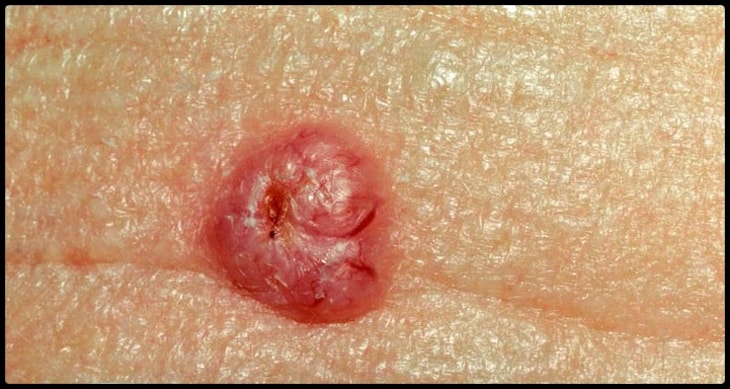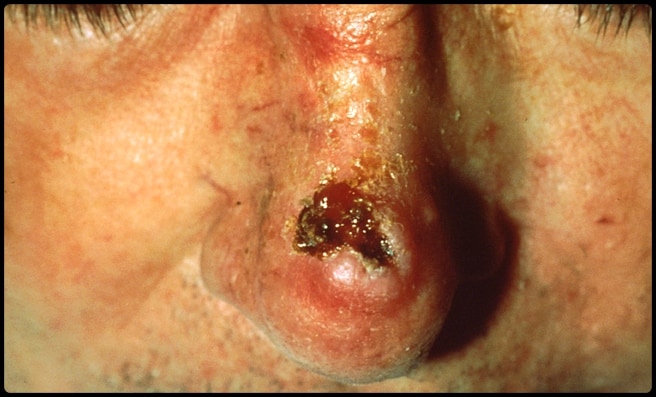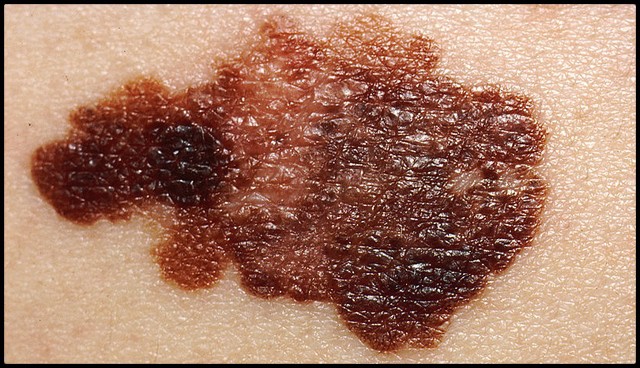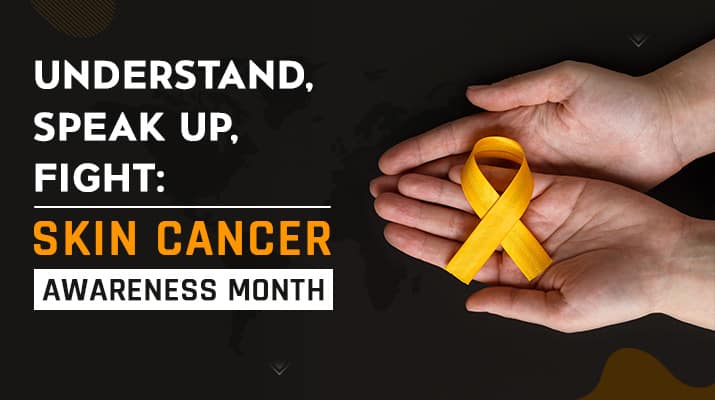Skin Cancer Awareness Month
While skin cancer is one of the most preventable forms of cancer, it’s also one of the most common. Approximately 9,500 Americans are diagnosed with some form of skin cancer every day. Luckily, it’s also the most treatable. With a five-year survival rate of 90%, most forms of melanoma are considered entirely preventable. However, within these statistics, at least one person dies every half hour from melanoma. Unfortunately, that number is far too high for such a preventable disease.
May is Skin Cancer Awareness Month, a campaign to raise public awareness regarding the dangers of the disease. From prevention techniques to body checks and seeking a quick diagnosis, everyone must understand the risks of skin cancer.
Types of Skin Cancer
In simple terms, skin cancer occurs when skin cells begin to multiply and expand uncontrollably. Typically, new skin cells form as older ones die. However, when this process stops working properly, cells can begin to grow at a fast rate, sometimes producing abnormal cells. This growth of cells is often non-cancerous and won’t spread throughout the body.
The most significant risk factor involved in developing skin cancer is exposure to sunlight. Harmful UV rays from the sun can damage the DNA in skin cells, leading to cellular defects and mutations that cause skin cancer.
There are three main types of skin cancer:
1. Basal Cell Carcinoma
 Basal Cell Carcinoma is a form of skin cancer that develops in the basal cells, a cell type that produces new skin cells as old ones deteriorate and die. Usually, this cancer appears as a small, sometimes transparent, bump, but it can also occur as brown, blue, or black lesions on the skin. It’s a condition that typically appears on patches of skin that have had long-term exposure to UV rays, such as the face, shoulders, ears, and nose.
Basal Cell Carcinoma is a form of skin cancer that develops in the basal cells, a cell type that produces new skin cells as old ones deteriorate and die. Usually, this cancer appears as a small, sometimes transparent, bump, but it can also occur as brown, blue, or black lesions on the skin. It’s a condition that typically appears on patches of skin that have had long-term exposure to UV rays, such as the face, shoulders, ears, and nose.
– Prevention
If you observe changes to your skin or any quickly evolving bumps on your skin, you will want to contact a doctor for a consultation. Additionally, minimizing exposure to certain activities can significantly reduce the chances of developing the condition. These include:
- Avoid direct exposure to sunlight. UV rays can still penetrate cloud cover and damage your skin, even on overcast winter days.
- Wearing the appropriate SPF sunscreen is a great way to protect your skin when avoiding direct sun exposure is an issue. Apply generously, and remember to reapply once every few hours at a minimum.
- Much like the sun, tanning beds produce an abundance of UV light. These UV rays can damage skin and increase the chances of developing Basal Cell Carcinoma.
- Wear Protective Clothing
2. Squamous Cell Carcinoma
 The exponential growth of squamous cells often characterizes the second most common form of skin cancer, Squamous Cell Carcinoma. A squamous cell is a flat type of cell located at the top layer of the skin that sheds older cells as a new form. UV radiation exposure to these cells can trigger mutations or abnormal alterations to these cells.
The exponential growth of squamous cells often characterizes the second most common form of skin cancer, Squamous Cell Carcinoma. A squamous cell is a flat type of cell located at the top layer of the skin that sheds older cells as a new form. UV radiation exposure to these cells can trigger mutations or abnormal alterations to these cells.
Typically, Squamous Cell Carcinoma manifests as red, scaly patches, wart-like growths, or open sores on the skin. And, like basal cell carcinoma, it also tends to form in regions that have seen UV exposure. However, this may not always be the case as it can also develop in other areas of the body.
An issue with detecting Squamous Cell Carcinoma is that its signs can look different from patient to patient. However, if you detect any new or abnormally changing growth, soreness, or discoloration on your skin, you’ll want to consult with a dermatologist as soon as possible.
3. Melanoma
 The most severe form of skin cancer, melanoma, typically develops in the cells that produce melanin, the chemical that produces your skin color. While this condition typically appears on areas that have been exposed to UV light, it can also pop up in your eyes, inside your body, and even your nose and throat, in rare cases.
The most severe form of skin cancer, melanoma, typically develops in the cells that produce melanin, the chemical that produces your skin color. While this condition typically appears on areas that have been exposed to UV light, it can also pop up in your eyes, inside your body, and even your nose and throat, in rare cases.
While the exact cause of melanoma isn’t fully understood, it’s thought that UV ray exposure likely plays a part. Whether by direct exposure to sunlight or via a tanning bed, ultraviolet radiation can significantly increase the likelihood of cancer cell development.
What Are the Signs and Symptoms of Skin Cancer?
As we’ve mentioned, skin cancer typically appears on areas of your skin that see regular exposure to the sun. This can be the chest, face, arms, ears, and even legs. However, this is not always a rule, as it can manifest in other less exposed areas. That’s precisely why it’s so crucial to remain vigilant toward any changes in your skin. You’ll want to watch for:
• Skin Lesions
Any recurring sores and lesions that are slow to heal may be cancerous.
• Asymmetry
If you notice changes to moles, warts, or freckles that appear in an asymmetrical pattern, you will want to consult a doctor.
• Border
The border of certain moles or marks may suddenly change size.
• Color
Any bumps or marks that quickly change color or size should be investigated by a doctor as soon as possible.
• Evolving Marks
A medical professional should inspect any mark on your skin that shows sudden changes in size.
The Causes of Skin Cancer
In most cases, skin cancer occurs when the body’s cells cannot repair themselves due to damage to their DNA. This damage can be spurred by several factors, including exposure, genetics, and even skin type. In most cases, however, exposure to ultraviolet rays from direct sunlight and tanning beds are the prevailing cause. Beyond UV exposure, other causes can include:
- Family history of skin cancer
- Tobacco use
- Exposure to chemicals such as arsenic, coal, and petroleum-based products
- Certain syndromes such as Gorlin syndrome a rare disorder that affects numerous organs in the body.
- Radiation therapy exposure
- Weakened immune systems caused by disease, viruses, and immunosuppressants
Stages of Skin Cancer
The process of diagnosing skin cancer is a process that should be left to a fully trained medical professional. After an initial consultation, your doctor will likely require a biopsy or sample of the affected site. Here, the sample will be sent off to be confirmed through testing.
If your sample returns positive for cancer cells, your physician will factor in several things to determine the severity of the issue, including:
- The size of the tumor, bump, or lesion in question
- If the cells have spread to your lymph nodes
- Whether cancer has spread to other parts of the body
The stages of skin cancer are broken down here:
1. Stage 0
Cancer cells have yet to spread beyond the epidermis or outer layer of skin.
2. Stage 1
Cancer cells have spread to the dermis but remain smaller than several centimeters.
3. Stage 2
In this stage, the tumor or growth has grown to larger than two centimeters but has yet to spread to other nearby body parts or lymph nodes.
4. Stage 3
Cancer has spread beyond the tumor into nearby skin or bone tissue. Although larger than three centimeters, it has yet to spread to distant body areas.
5. Stage 4
The most advanced stage of melanoma, stage 4, indicates that cancer has spread beyond the tumor into lymph nodes, organs, and many other tissues of the body.
Skin Cancer Treatments
When it comes to skin cancer, there are many effective techniques. Depending on type and severity, your dermatologist may choose one of these remedies:
1. Cryotherapy
A skin dermatologist typically performs this treatment on moles or growths and uses liquid nitrogen to freeze the tissue, destroying cancer cells as it thaws.
2. Excisional Surgery
Excisional surgery involves a physician cutting out the growth in question, along with some healthy skin surrounding it to ensure that it doesn’t return.
3. Mohs Surgery
This technique involves removing a growth layer by layer and examining it with a microscope until it’s deemed that no irregular cells are present.
4. Curettage and Electrodesiccation
With this procedure, a spoon-like blade scrapes away cancer cells little by little, and the remaining growth is burned with an electric needle to prevent further development.
5. Chemotherapy
Chemotherapy is probably the most well-known cancer treatment. This process requires specific chemicals to be taken orally or injected to target and kill cancer cells.
6. Radiation Therapy
High-powered energy beams of ionized radiation are directed to certain parts of the body to inhibit or destroy cancer cells.
7. Biological Therapy
Biological therapy is a treatment that uses substances and chemicals from living organisms to stimulate the immune system to treat cancer.
Preventing Skin Cancer
While skin cancer may not always be completely preventable, you can take plenty of steps to minimize your chances of crossing paths with the disease. These include:
- Avoid direct exposure to the sun. Using brimmed hats, sunscreen, sunglasses, and thick clothing is a great way to limit UV exposure.
- Avoid the use of tanning beds or sun lamps.
- Minimize exposure to certain chemicals found in everyday products
- Check your skin thoroughly for any changing bumps, marks, or moles.
Winston Salem Dermatology is Dedicated to Diagnosing, Treating, and Beating Skin Cancer
May is Skin Cancer Awareness Month, a time devoted to informing the world about the risks and dangers of various forms of skin cancer. Skin cancer is an illness that affects thousands of individuals each day. Most forms of skin cancer are easily treatable and have high survival rates if caught early enough. But a large part of surviving cancer is early detection. The more we understand, speak up, and fight, the better our chances of beating the illness.
Winston Salem Dermatology has years of experience in diagnosing and treating various forms of skin cancer. Our office is also proud to offer modern treatments and techniques for various skin issues.
In addition to medical treatments, we also offer a cutting-edge lineup of cosmetic skincare procedures to illuminate and reinvigorate your youthful appearance.
So, if you’re worried about a mark or bump on your skin that’s suddenly changing size, shape, or color, give us a call at (336) 774-8636 and let our skin specialists help you. You’re only at your best when your skin is, so call Winston Salem Dermatology to schedule your treatment today!


